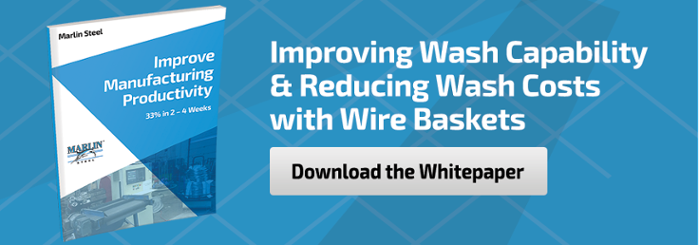 Marlin Steel owes a lot to the teachings of productivity luminaries such as Eliyahu M. Goldratt and Shigeo Shingo. By following the teachings of these masters of continuous improvement in manufacturing productivity, Marlin has come a long way in the 20 years following the company’s relocation to Baltimore.
Marlin Steel owes a lot to the teachings of productivity luminaries such as Eliyahu M. Goldratt and Shigeo Shingo. By following the teachings of these masters of continuous improvement in manufacturing productivity, Marlin has come a long way in the 20 years following the company’s relocation to Baltimore.
Not only has Marlin’s factory floor grown in size, the company now has twice the staff and is many times more productive and profitable than it was in 1996. This increase in productivity wouldn’t be possible without making constant process improvements and making sure that the improvements stuck.
How does Marlin sustain process improvements in manufacturing?
By Leading and Motivating Workers Out of the “Land of Problems”
It doesn’t matter how many process improvements a company comes up with if there’s no buy-in from the frontline workers who carry out said processes.
As Edward Conklin of peninsula.org noted in a communication with Marlin after watching a video of Goldratt’s last speech, “as a process engineer the process improvement part was fun, but without leading and motivating we would never sustain.”
Conklin was absolutely right. Without buy-in from frontline workers, no process improvement can be sustained for long, as unmotivated workers quickly revert to old processes and techniques because they’re comfortable or familiar.
As Conklin would put it, the goal is to “move from the Land of Problems to the Land of Opportunity” on all projects. In the “Land of Problems,” workers suffer from:
- Low productivity
- Lack of instruction
- Bad behavior
- Focusing on “firefighting” tasks
- Lack of employee engagement
Just to name a few of the issues.
According to Conklin, a company in the “Land of Problems” might have a workforce consisting of about: 25% “rowers,” or actively engaged employees who produce the majority of results, 50% “watchers,” or passive participants who aren’t engaged, but aren’t actively disengaged either, 23% “grumblers,” or disengaged workers who complain about their jobs regularly, and 2% “saboteurs” who actively work against the company’s best interests.
A lack of engagement and instruction leads to low adoption of process improvements, and below average effort by the majority of the workforce overall. To improve processes, a company must first start by improving the workforce itself and creating a “Land of Opportunity” environment.
From Problems to Opportunities
At Marlin, a “Land of Opportunity” environment was created through systematic changes to the company’s day-to-day operations.
First, Marlin began to adopt high-precision factory automation to handle the dirtiest, most dangerous jobs on the factory floor, moving the manufacturing crew into supervisory roles over the machines. This helped to reduce the physical stress and risk of harm that employees were exposed to.
These safety gains were further cemented by the creation of an employee-led safety committee that was empowered to make changes for the safety of Marlin’s workers.
Second, Marlin initiated a new job skills matrix program, where employees were encouraged to learn new, job-critical skills. Each new skill learned led to a permanent pay increase, which helped to create a team of knowledgeable, well-rounded employees who could be tasked in different work cells as needed. Fully 5% of Marlin’s payroll budget is dedicated to providing training in these skills.
Finally, Marlin set about establishing weekly productivity goals that were tough to meet, but doable. When a work cell met its goals, every employee in that cell would receive a pay bonus on their next paycheck. This encourages every member of a work cell to do their best to meet goals, because nobody wants to be the person who cost the whole team their bonus.
These programs helped to transform Marlin’s workforce into an incredibly efficient team of “rowers” who constantly seek to improve their productivity. The watchers, grumblers, and saboteurs quickly transformed into rowers, or were weeded out. There’s no room for someone who won’t pull their own weight when everyone else’s paychecks are on line.
The combination of having the right tools, the right knowledge, and the motivation to use them to meet production goals allowed Marlin to make numerous process improvements, and then sustain them in the years to follow.
Special thanks to Edward Conklin of peninsula.org for his input.



.gif)


